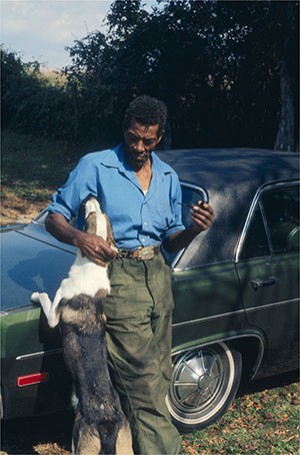Born 1904, died 1980, Delaplane, Virginia
Steve Ashby lived his entire life in a small town in Virginia, an unincorporated community roughly fifty miles west of Washington, DC. The son of an emancipated slave, he was the second of twelve children. Outside of a brief stint as a restaurant waiter, Ashby spent most of his life working the soil as a farmer and gardener until he retired in 1950. Although he had tinkered with small-scale wooden sculptures throughout his life, it was only after the death of his wife in 1960 that he started to experiment with figural sculptures.
Assemblages of found materials such as plywood, lumber, scraps of hardware, discarded children’s toys, and photographs, Ashby’s “fixing ups,” as he called them, combined a crude, expressionistic sculptural style with wry humor and occasionally overt eroticism. While two disco dancers innocently flirt on the dance floor, their hips joined and their glances just missing each other, a female figure in another work crouches and unabashedly exposes herself to the viewer. Narratives, when suggested, are ambiguous, but they often reflect Ashby’s engagement with multiple forms of black popular culture. In one sculpture, a dandyesque figure straight out of the Blaxploitation films of the 1960s and 1970s saunters past a partly nude couple grooming a horse. In another, Ashby directly addresses the endemic racial violence faced by African Americans. A white hunter directs his rifle barrel downward, peering through the gun’s scope at a lifeless black body sprawled on the ground. In appraising these works, the viewer is struck by Ashby’s jarring juxtapositions and their contemporary relevance, which force us to acknowledge the ubiquity and persistence of racism.
Ashby originally installed many of his assemblages around his yard in Delaplane, creating a grand tableau that testified to his imaginative and idiosyncratic vision. His work was greatly admired by the local community but was rarely seen more widely until its posthumous inclusion in Black Folk Art in America, 1930–1980 at the Corcoran Gallery of Art, Washington, DC, in 1982.
Nicholas Miller
Livingston, Jane, and John Beardsley, eds. Black Folk Art in America, 1930–1980. Washington, DC: Corcoran Gallery of Art, with the University of Mississippi Press, Jackson, 1982.
